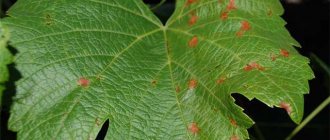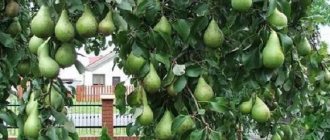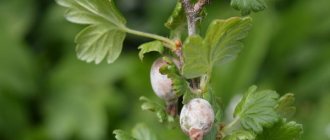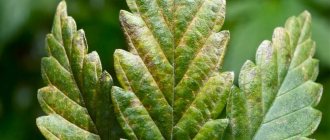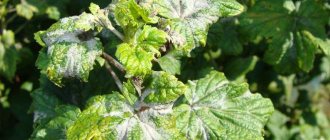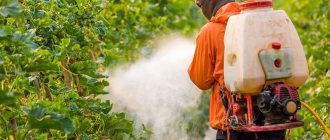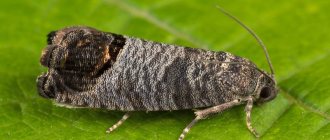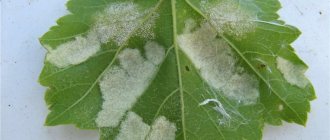Powdery mildew
This disease is fungal. In affected bushes, whitish spots form on the foliage and shoots, which, as the disease progresses, spread over the entire surface of the plant and change their color to brown. The foliage tissue under such a coating becomes more fragile, and it dries out and curls. The stems grow more slowly, the pumpkins begin to lag behind in development, and they also become of lower quality and the amount of sugar in them decreases. If symptoms of this disease are found on the bushes, they must be treated with sulfur powder (80%), while 4 grams of the substance are taken per 1 square meter of the bed. If necessary, plantings can be treated several times, with an interval of 3 weeks between treatments. At least 20 days before harvesting, any processing must be stopped.
Downy mildew (peronospora)
In diseased bushes, green-yellow spots form on the leaf blades. They grow rapidly and after a short time cover the entire surface of the leaf. If high humidity is observed for quite a long time, then a violet-gray coating appears on the underside of the leaf plate, which contains fungal spores. For preventive purposes, one should not neglect the pre-sowing preparation of seeds. To do this, they are poured into a thermos filled with hot (about 45 degrees) water for 2 hours, after which they are immersed in a solution of potassium permanganate (1%) for a third of an hour. If diseased plants are found, the entire area must be sprayed with a urea solution (10 grams of substance per 10 liters of water). If this method of combating the disease turns out to be ineffective, the melons need to be treated with a solution of Oxychome or Topaz, and you must follow the instructions attached to the drug.
Fusarium wilt
This is also a fungal disease; its pathogens are found in the soil, from which they fall on plant remains or on melon seed. Most often, melons of late-ripening and mid-ripening varieties are affected by this disease. Diseased bushes experience a decrease in yield, as well as a deterioration in the quality of pumpkins. Symptoms of this disease appear during the formation of the second or third true leaf plate or during the ripening period of pumpkins. The foliage of the affected bushes becomes light, and many gray spots appear on its surface. The infected above-ground parts begin to wither, and after 1.5 weeks the plant dies completely. Affected plants must be sprayed with a solution of potassium chloride during the formation of buds. For preventive purposes, before sowing, the seeds must be kept in a formaldehyde solution (40%) for 5 minutes.
Copperhead (anthracnose)
On the surface of the leaf blades, spots of a round shape and a pale pink or brown color form. Over time, these spots become larger. Holes appear on infected leaf blades, curling of the leaves and drying out of the entire bush are also observed. There is a thinning of the lashes, which become very fragile, and the pumpkins are deformed and rot appears on them. Infected melons must be sprayed with Bordeaux mixture (1%), which will require 3 or 4 procedures, which are carried out once every 1.5 weeks. Instead, the entire melon patch can be dusted with sulfur powder.
Ascochyta blight
This disease is also fungal. In plants grown in greenhouses, after infection, areas of brown color appear on the shoots, and over time they spread throughout the entire bush. A diseased bush dies as a result of damage to the root part. If signs of infection with this disease are found, then it is necessary to adjust the watering, significantly reducing it, and the infected areas of the melon should be dusted with a mixture consisting of wood ash and lime, or the bushes can be treated with Bordeaux mixture (1%). For preventive purposes, the seed must be disinfected before sowing; for this purpose, Silk or Immunocytophyte is used.
Root rot
Weakened plants are susceptible to this disease. It is noteworthy that in young specimens the roots and stem first become brown, after which they become thinner and the bush withers. In an adult plant, yellowing and wilting of the aerial parts are also observed, and the roots and lower part of the stem turn brown. For preventive purposes, before sowing, the seed should be kept for 5 minutes in a formaldehyde solution (40%).
Prevention methods
To prevent crops from diseases, both universal methods and methods for preventing specific diseases are used. To increase the general immunity of melons, the soil is regularly weeded to remove weeds, crop rotation rules are followed, and dead and infected fruits and bushes are destroyed.
Prophylaxis against specific diseases is carried out:
- against powdery mildew, root rot, fusarium, plants are systematically watered;
- after harvesting, plow the soil: this saves future plantings from peronospora, ascochyta, fusarium (against septoria, the soil is dug especially deeply, up to 25–30 cm);
- heat treat the seeds before planting with warm water (+45°C): this protects the seedlings from peronosporosis and cucumber mosaic;
- melons are fed with potassium fertilizers to prevent ascochyta blight;
- the seeds are treated before planting: against peronosporosis and other fungal diseases, they are soaked in a 1% solution of potassium permanganate for 20 minutes or in a solution of “Fitosporin-M” (1.5 g/l), against fusarium - in a 0.1% solution “Baktofit” for 3 hours, for root rot use a 40% formaldehyde solution for 5 minutes, for bacteriosis - a solution of potassium permanganate, aloe juice or hot water.
Viral diseases
Cucumber mosaic virus, subspecialty virus and watermelon mosaic virus. Their main carriers are aphids, therefore, if this pest is detected, you should try to get rid of it as soon as possible. If the melon is affected by any of the listed diseases, then it must be removed from the ground as soon as possible and destroyed. The fact is that to date no effective drug has been found for viral diseases. Signs of viral diseases: areas with a mosaic color form on the leaf blades, internodes are shortened, the bush lags behind in development, the foliage is deformed, the ovaries crumble, and specks appear on the surface of the pumpkins.
Melon diseases, control and prevention
Melons are susceptible to fungal, bacterial and viral diseases. Infection can be triggered by low-quality seeds, failure to maintain trade turnover, sudden temperature changes, stagnation of moisture in the soil, and watering with cold water.
Many melon diseases can be treated to minimize the damage they cause to the plant. But in order to maintain the productivity of the crop, fungicides should be treated at the initial stage of their development. Plant infection is possible both when growing melon in a greenhouse and in open ground.
Powdery mildew
This fungal disease can be recognized by the white coating on the leaves. Initially, it appears as small spots, which later increase and merge into a single whole. This interferes with the process of photosynthesis and disrupts metabolic processes in tissues. As a result, the affected leaves turn brown and wilt. Provoking factors for powdery mildew are high humidity, dense plantings and high temperature.
Crop rotation, timely removal of weeds and loosening of the soil help prevent the development of melon disease.
When the first signs of powdery mildew appear, it is necessary to spray the bushes twice with colloidal sulfur at the rate of 50-100 g per bucket of water with an interval of 1 week. The waiting period before harvesting is 20 days.
Downy mildew
This fungal disease is called peronosporosis. Signs of damage can be found on melon leaves in the form of yellow-green spots that quickly increase in size and merge into a single whole. With further development, a gray-violet coating appears on the reverse side of the affected plates, due to sporulation of the fungus.
The main difference between downy mildew is its rapid development. Even in the evening, a completely healthy melon bush may have obvious signs of downy mildew in the morning. The disease is treatable only at the initial stage of development. To do this, it is necessary to use fungicides such as Oxychom or Topaz. Treat every 7 days until the young leaves are completely healthy.
Pre-sowing seed treatment helps prevent infection. To do this, they must initially be kept for 2 hours in a thermos with water, the temperature of which should be within 45 degrees. When finished, lower the seeds for 15 minutes. into a pink solution of potassium permanganate, and then rinse.
On a note! Timely feeding, taking into account the stage of development of the melon, helps increase the plant’s resistance to diseases.
Fusarium wilt
This disease is caused by soil fungi that attack the root system of melon. This leads to disruption of metabolic processes, as a result of which nutritional components do not reach the above-ground part of the plant. This is the reason why melon leaves initially lose turgor, and then turn yellow and completely wither.
Prolonged stagnation of moisture in the soil and sudden changes in day and night temperatures contribute to the development of Fusarium wilt. This disease cannot be treated. Therefore, if the leaves of a melon suddenly turn yellow and become limp, then it is necessary to completely remove the entire bush and water the soil with a solution of Previcura Energy or Maxima. This procedure will disinfect the soil and prevent further spread of the melon disease.
As a preventative measure, it is necessary to plant this crop on high ridges. In the fall, if necessary, sand should be added to the site at the rate of 10 kg per 1 sq. m. m. and dig up on the bayonet of a shovel. And also throughout the season, make sure that watering is moderate.
Ascochyta blight
This fungal disease affects melons when they are grown in a greenhouse. Ascochyta blight can be recognized by the light brown spots that cover the leaves and shoots of the plant. Development is provoked by high humidity and lack of ventilation. If left untreated, the affected bush dies, as the disease affects its root part.
Ascochytasis can be treated at the initial stage of development. To combat it, it is necessary to treat the bushes with a 1% solution of Bordeaux mixture. The procedure must be repeated every 7 days until the plant recovers.
As a preventative measure, seeds should be treated with potassium permanganate before planting, and the temperature and humidity in the greenhouse should be monitored throughout the growing season.
Cucumber mosaic
This is a viral disease of melon, transmitted by aphids. You can recognize it by the yellow stripes that are located parallel to the veins. Subsequently, they turn into spots of different shapes and cover most of the leaf. The affected plates noticeably lag behind in development and become deformed over time.
Subsequently, the cucumber mosaic extends to the buds of the plant. This leads to the absence of ovary and death of the bush.
This disease cannot be cured. Therefore, you need to regularly inspect plants for aphids and treat them with insecticides when the first signs of the pest appear. You should also fight cucumber mosaic at the seed preparation stage. Planting material must be kept for 3 days at a temperature of +51 degrees, and then another day at +80 degrees.
On a note! Cucumber mosaic also spreads through the roots of weeds, so you need to do weeding regularly.
Pests
The following insects can harm this plant: spider mites, gnawing cutworms, melon aphids and wireworms.
melon aphid
Its accumulation is observed on the underside of the sheet plates. Aphids suck the sap from the bush, which causes the foliage to dry out and curl, and the flowers fall off before they even have time to open. In addition, this pest is the main carrier of dangerous incurable diseases. To get rid of aphids, the bushes should be treated with a solution of Actellik (30%) or Karbofos (10%).
Spider mites
This pest, just like aphids, settles on the underside of leaves. Ticks suck sap from the bush. These pests pose the greatest danger to melons that are grown in a greenhouse, but they can also settle on melon bushes. Affected bushes should be sprayed with a solution of Bicol, Fitoverm or Bitoxibacillin.
Wireworms
The wireworm is actually the larva of a click beetle. They damage the root system of the bushes, causing the melons to die. To prevent the proliferation of such a pest, the site will need deep digging in the autumn, and you must also adhere to the rules of crop rotation.
Gnawing cutworms
The caterpillars of the gnawing cutworm are dangerous for the melon because they gnaw the stem of the bush, causing it to die. To destroy the caterpillars, you will need to deeply dig up the area, but only after the crop has been harvested. For prevention purposes, it is imperative to adhere to the rules of crop rotation.
Planting melons in open ground
What time to plant
Melon seedlings can be planted in open soil only when the plants are 4 to 5 weeks old, and they should have formed 5 or 6 true leaf blades. However, experienced gardeners recommend waiting until the return spring frosts are left behind, and only then planting melons in open ground. If there is a threat of frost, but the melons are already planted in open soil, then they need to be covered with film on top.
This plant is a heat-loving plant, so for planting it you should choose a well-lit and heated area that has reliable protection from the cold wind. It is very good if melons grow on the south side of the garden. This crop grows very well after black fallow, and the best predecessors are: corn, cucumbers, garlic, cabbage, winter wheat, barley, onions and legumes. It is not recommended to plant melon in the same area for two years in a row. The worst predecessors of such a crop are tomatoes and carrots. Next to the melon, you can grow beans, chard, sorrel, corn, turnips, basil, radishes and radishes. But you can’t grow cucumbers and potatoes next door.
Suitable soil
The soil should be light and neutral, but rich in organic matter. The melon will be able to grow on saline or dry soil, but it will die on wet and acidic soil. This crop grows best on medium-loamy, light soil, while heavy loam or sandy soil is not suitable for this purpose.
Before planting seedlings, the soil on the site must be prepared. To do this, in the autumn, 4 to 5 kilograms of manure or humus per 1 m2 must be added to the soil for digging to the depth of a spade bayonet. At the same time, you still need to add ½ bucket of sand per 1 square meter of area into clay soil. In spring, the area should be harrowed, with 35 to 45 grams of superphosphate and 15 to 25 grams of potassium salt added to the soil per 1 square meter. Before directly planting seedlings, the area must be dug up again, and nitrogen-containing fertilizers from 15 to 25 grams per 1 square meter are added to the ground.
PLANTING MELON SEEDLINGS!! FIRST TIPS FOR FORMATION!
Rules for planting in open ground
To begin with, planting holes should be prepared on the site, the distance between them should be at least 0.6 m. Before planting, the seedlings must be watered very well, which will allow you to easily remove the plants from the cups. The row spacing should be about 0.7 m. When planting plants, you should pay attention to the fact that their root collar rises above the soil surface, otherwise it may be affected by a fungal disease or rot will form on it. With this method of planting, it turns out that the melon seems to be placed on a tubercle. In order to prevent fungal diseases, when the seedlings are planted, the surface of the soil on the site will need to be covered with a layer of river sand. For the first 2 days, the planted plants will need protection from direct sunlight; for this, wet paper is used.
Growing melon in a greenhouse
Melon in a greenhouse is grown on trellises, which saves space. Seedlings are planted in holes measuring 70x50 centimeters, while a distance of 20 centimeters must be maintained between the bushes. Planting is carried out at the same time as transplanting seedlings into open soil. Caring for melon seedlings, as well as the procedure for hardening them, are described in detail above. At the same time, melons, tomatoes and peppers can be grown in the same greenhouse. However, it is better not to plant melons, zucchini and cucumbers together. Immediately before planting, you need to add one and a half kilograms of compost or humus to the prepared planting holes, cover it with a three-centimeter thick layer of soil, after which lukewarm water is poured into the hole. Then you need to plant the melon in it along with a lump of earth by transshipment, and it should rise above the bed by 15–30 mm, otherwise rot may appear on the subcotyledon. In case of frost, the plants will need to be protected by constructing additional frames with film.
During the first 7 days after planting the seedlings in the garden, if the greenhouse becomes hotter than 30 degrees, it must be ventilated. 1–1.5 weeks after planting, a couple of liters of lukewarm water should be poured under each bush, to which nitrogen-containing fertilizers should be added (20 grams of ammonium nitrate per 1 bucket of water). Watering should be done once a week, however, during fruit ripening, the frequency of watering should be gradually reduced until it stops completely for 7-15 days until the melons are completely ripe. As a result, the fruit will be much sweeter.
The plants need to be fed 2 times with an interval of 15–20 days, using organic fertilizers. In this case, you need to alternate feeding with herbal infusion and infusion of mullein, chicken droppings or humus, and one handful of wood ash should be poured under each plant.
When 7 days have passed since the melons were planted in the greenhouse, the plants should be pinched above the 5th or 6th leaf plate, after which they should grow side shoots with female flowers. Select the 2 most powerful lashes that need to be tied to the trellis, and the remaining ones need to be trimmed. As these lashes grow, they should be wrapped around the twine on the trellis, because they will not be able to climb it on their own. If there are not enough pollinating insects in the greenhouse, the plant will have to be pollinated manually. Take a brush and pick up pollen from a male flower (it does not have an ovary), after which it is transferred to the pistil of a female flower. After melons have formed on the bushes, two or three melons should be left on each of them, and the excess ones should be torn off. When the size of the fruit reaches the size of a tennis ball, it must be placed in a net, which must be hung on a horizontal trellis guide.
In some cases, bushes in a greenhouse may be affected by a fungal disease or pests (cutworms, melon aphids or spider mites) settle on them. To get rid of pests, the bushes need to be sprayed with Fitoverm or Iskra-bio. The fight against various diseases will be discussed in detail below. As soon as the size and color of the melon becomes characteristic of a given variety, it must be removed, while paying attention to the connection of the pumpkin with the vine; cracks should form on it.
How to grow large and sweet melons in a greenhouse?
Melon processing
Bushes affected by a fungal disease are treated with fungicidal preparations, and at least 2–4 procedures are carried out. In the intervals between treatments, the use of contact preparations is prohibited. You also cannot alternate fungicides from different chemical groups; you must use either the same drug or its analogue. The duration of breaks between treatments should not exceed 12 days. After the melons have been treated with a systemic fungicide for the last time, a contact agent can be used only when 8–10 days have passed, not earlier. Experts advise using systemic fungicides to treat young bushes that are growing and developing intensively. In this case, it is best to use contact preparations for treating adult specimens.
Share
Rosa, but not the same
The most harmful disease on cucumbers is powdery mildew.
– It manifests itself primarily on the leaves: a kind of powdery coating forms on them, as if they had been sprinkled with flour. Powdery mildew is brought into greenhouses first of all by gardeners themselves. They walk along the paths to the garden, and there are probably diseased plants there, and so they bring the disease to themselves from their clothes,” says Ural State University Professor Anna Yurina. - We have to be careful. And if the disease has entered the greenhouse, then make sure that the outbreak does not spread: tear off the leaves affected by the plaque. Of course, there are also chemicals for this, for example, the well-known Bordeaux mixture, but it is better not to use aggressive agents in your greenhouse.
Cucumbers also have a dangerous pest – spider mites. Due to its small size, it is practically invisible, and most often it can only be seen under a magnifying glass on the back of a cucumber leaf: the mite looks like moving dark dots. This pest is especially dangerous in greenhouses and greenhouses.
– To combat spider mites, it is recommended to increase the humidity in the greenhouse: in such a climate this spider does not reproduce. Humidity should be 85 percent, or even 90 if there are a lot of pests, says Anna Yurina. – But, as in the case of powdery mildew, it is necessary to promptly remove all leaves affected by the pest. This will help contain its spread.
In addition, cucumber plants often turn yellow and wither for no apparent reason. If you notice this in your garden, then most likely these are the consequences of root rot affecting the underground part of the plant. In this case, both sick and healthy cucumbers should be shed with a solution of preparations made from the soil fungus Trichoderma. These microorganisms are the main assistants to gardeners in the fight against fungal plant diseases. The drugs can be different: Trichodermin, Trichoderma veride, Gliocladin is now very popular. The latter, by the way, is usually added to the hole during planting in the greenhouse. It turns out to be good prevention against fungal diseases. After all, it is always better to prevent a plant disease than to selflessly fight it in the garden beds.
How to store mangoes?
Fresh mangoes can be stored for one to two weeks, while cut mangoes can be stored for no more than a day in the refrigerator.
If the mango is not yet fully ripe, you can wrap it in a paper bag and leave it at room temperature to ripen. If you want to speed up the process, put an apple or banana in the same bag, which will release ethylene, which accelerates ripening, and in this case the mango will ripen in about two to three days. Once the fruit is ripe, it can be stored in the refrigerator.
If you need to preserve the mango for a long time, you can freeze it. Freezing will turn the skin black, but the flesh will remain in good condition.
Preventive actions
Often, all kinds of preventive measures are the main condition for effectively combating any infection or pest. They allow you to create an optimal microclimate during which the melon will grow most quickly and bear fruit effectively. This directly affects the quality of the fruit, as well as the timing of their ripening, so all kinds of preventive measures when growing melons are a mandatory care procedure.
In order to prevent these pathologies, you should:
- Before sowing melons, disinfect the seeds by soaking them in 70% alcohol (5–10 minutes) or 2% potassium permanganate (15–20 minutes);
- Starting in the fall, carry out deep plowing of the soil to a depth of at least 30 cm;
- thoroughly clean the soil and area before wintering from the remains of any vegetation;
- follow the rules of crop rotation, melons are grown in the same place only every 3–4 years;
- feed the beds on time;
- create a regulated site moisture system;
- choose the right place for planting (open and well-lit areas, located on the plain or hills, protected from drafts and high humidity);
- Weed and loosen the beds at least once a week;
- Cultivate only high-quality hybrids that are naturally resistant to infections.
How to eat mango correctly?
The main rule in eating mango is not to overeat. Excessive consumption of mango pulp can contribute to the development of allergies and lead to digestive problems and a surge in blood sugar, especially if the fruit is consumed on an empty stomach.
“The recommended average norm for all fruits and berries is 300–400 grams per day,” says Natalya Fadeeva
. – Therefore, one mango per day is enough for a snack. You can eat it fresh, or you can make a smoothie or juice.
It is better not to eat mango on an empty stomach.
You can include fruit in your dinner. For example, add a few pieces to a turkey salad.
To avoid problems with the gastrointestinal tract, after eating unripe mangoes, you should not drink cold water, soda and sweet drinks, which will increase the harmful effects of organic acids.
Nutritional value and composition of mango
Fresh mango contains various vitamins, minerals, micro- and macroelements.
Beneficial properties of mango
Natalya Fadeeva
nutritionist-endocrinologist, doctor of medical sciences
– Mango is primarily a source of carbohydrates, plant fiber, vitamins, micro- and macroelements. Due to the large amount of dietary plant fiber, mango is useful for constipation because it stimulates bowel cleansing.
The fruit contains a lot of carotenoids and vitamin A, which are good for vision and various skin problems. A large amount of vitamin C is useful for colds and stress. B vitamins are important for diseases of the nervous system and improve brain function. Potassium and magnesium are needed for the cardiovascular system, and iron for anemia.
Restores the digestive system
Mango helps with problems with the stomach, intestines, stool or chronic constipation. A 2022 study found that after eating mangoes daily for four weeks, a person's digestive system improved due to the high amount of fiber in the fruit - 20% of the daily value.
According to the results of a 2022 study, dried fruit peel, which consists of 40% fiber, has prebiotic properties, which means it improves intestinal microflora.
Drugs for anthracnose
Fungicidal preparations are used to treat plants from fungal diseases, so we offer you a description of those that are used most often. So, fungicides for anthracnose:
- Abiga-Pik is a contact copper-containing fungicide with a broad spectrum of action. Moderately hazardous substance. If the instructions are strictly followed, it is not phytotoxic;
- Acrobat MC is a systemic-local drug used to treat many fungal diseases. Toxic;
- Bordeaux mixture (mixture) is a broad-spectrum contact fungicide designed to protect berry, melon, flower, vegetable and fruit crops from a whole range of diseases;
- Previkur is a systemic drug with protective and growth-stimulating properties. Used against many diseases. Moderately hazardous substance with a mild irritant effect on the skin and mucous membrane of the eyes;
- Ridomil Gold is a systemic contact drug to combat a whole range of diseases;
- Skor is a systemic fungicide with preventive and therapeutic action against many diseases - scab, powdery mildew, late blight, leaf curl, Alternaria and other fungal diseases. Moderately dangerous;
- Tiovit Jet is a contact fungicide and at the same time an acaricide. Used as a protective agent for fruit, vegetable, flower crops and grapes against fungal diseases. Moderately hazardous substance;
- Topsin-M is a systemic fungicide with therapeutic and preventive action, effective for soil treatment. Does not irritate mucous membranes and skin;
- Trichodermin is a biological fungicide with therapeutic and preventive action, a soil improver. Safe for humans, bees, fish and birds. Not phytotoxic. Does not accumulate in plants and soil;
- Fitosporin-M is a biological fungicide of contact action, a microbiological preparation for the protection of garden, garden, greenhouse and indoor plants from fungal and bacterial infections. Low toxicity for humans, but dangerous for plants and bees;
- Fundazol is a drug with a wide spectrum of systemic action, a seed protectant. It has healing and protective properties, but after 2-3 treatments, pathogens develop resistance;
- Strobi is a broad-spectrum local-systemic fungicide used to combat fungal diseases. Resistant to precipitation;
- Quadris is a broad-spectrum fungicide with preventive, therapeutic and eradicating effects and is used to combat fungal diseases;
- Kuproxat is a contact fungicide, a preventive herbicide to protect plants from fungal diseases. The best copper-containing drug;
- Oxychom is a systemic contact drug with a broad spectrum of action used to combat fungal diseases. Dangerous substance;
- Ordan is a contact-systemic fungicide used to combat Alternaria, late blight, anthracnose and other fungal diseases. Moderately hazardous substance.
Benefits of mango for women
Vitamin C helps the body produce collagen, a protein that strengthens hair roots, restores their condition and actively accelerates growth. Therefore, mangoes are used in cosmetology: fruit extracts are often added to creams, serums and hair masks.
The vitamin A contained in mangoes prolongs the youthfulness of the skin.
Mango also reduces symptoms of toxicosis, nausea, heartburn during pregnancy and breastfeeding. But before including mangoes in your diet, you should consult your doctor so as not to cause an allergic reaction in yourself or your child.
Polyphenols, carotenoids, vitamin C and terpenoids in mango suppress the development of breast, colon, liver and other tumor cells.
